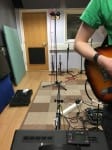Once we’d recorded all of the music, it was time to mix it. Adam and I split the duties between us whilst mixing together. He would normally work on the drum parts first whilst I would focus on guitar and vocals before working on an overall mix between us. This worked well and I think between us we got the sound that we both hoped for.
The first songs that we worked on were ‘Ironic Veronica’ and ‘Baby’ as we had recorded them first and had completed tracking. ‘IV’ had been recorded with a 12-string acoustic guitar which actually caused a few problems in mixing due to the higher timbre of the instrument to that of a normal 6-string guitar. This required a lot of EQ to balance the harsh high-end frequencies within the song. This freed up a lot of the space for the both the bass guitar and the kick drum which occupy the low-end of the mix. The arpeggio guitar was also a fairly high-end based part as it had been recorded with a capo on the 7th fret. As seen in the pictures below the 12 string had to have several frequencies notched out to get rid of ‘rings’ in the instrument. There was also a timing problem with the 12-string part as it had been made up of two takes which meant cutting out the guitar in the middle section. This didn’t matter as there were enough other parts to cover it up.
The middle section had a lot of mixing involved too. I had performed a harmonics part on the guitar which was meant to back up the solo heard but we found that it was barely audible. I decided to add a lot more reverb to it (DVerb to be specific) and put a slight delay on it to make the part more prominent. This resulted in an ethereal part that added another texture to the song. It blended well with the string part which was added in to be reminiscent of the songs from ‘Out of Time’ such as ‘Near Wild Heaven’ or ‘Shiny Happy People’.
The bass guitar in all four songs (wasn’t in ‘Father, Son’) was treated the same to keep consistency within the album. It was always recorded with a microphone (in one case 3) rather than a DI to pick up the low frequencies better. ‘For My Next Trick…’ had a 3 mic setup which caused problems in mixing as it was muddying up the overall song. Light compression was always added to make the bass pop where needed and we typically equalised it with a high-pass filter to cut off the sub-bass frequencies and turning up the mid-high frequencies a bit to add a bit of punch. This was a technique gathered from our research http://www.soundonsound.com/sos/sep12/articles/mixing-bass.htm
The vocals tended to have the same processes added to them too. Light reverb was added to all the vocal tracks to give them a bit more presence. This was a personal preference of John Lennon’s and is something which I always apply to my vocals. The same EQ pre-set was used across all 5 songs too which was ‘Smooth Vocal’ as it seemed to work well with my lead vocal parts, bringing out the low-mid frequencies in my voice and cutting off the high-end which could be harsh at times. The backing vocals featured prominently in all 4 songs were also doused with reverb (normally a church hall setting to blend them better). The EQ’s differed from each one as I would prioritise the low-ends in the lower harmonies and higher frequencies in the higher parts. I would choose the closest 2 harmonies to be higher in the mix as they blend better and the higher ones could sometimes be a bit shrill in places. This was evident on both ‘Baby’ and ‘Ironic Veronica’ where the lower harmonies were prioritised over the highest one. In the case of ‘Sip a Fizzy Pop’, the opposite happened as the higher 2 harmonies were closer, thus making a better blend. The song had some ‘Beach Boys-esque’ harmonies in the chorus and as a homage to that I prioritised the highest harmony in the style of Brian Wilson who would add a layer of falsetto harmonies to songs such as ‘I Get Around’ and ‘Good Vibrations’ (LO3).
The EP was mainly guitar-oriented and feature a wide array of different sounds produced by the instrument. I tended to add EQ with the HMF turned up a bit more to add a punchier sound, reminiscent of ‘Suck it and See’. This is particularly evident of ‘Baby’ to make space for the bass guitar and ‘Sip a Fizzy Pop’. Another guitar that was used on the song was Patrick’s electric 12 string on which he played arpeggios throughout the song in the style of Johnny Marr from ‘The Smiths’ or Roger McGuinn from ‘The Byrds’. As his line reminded me of the latter’s playing style I put some research into how that was recorded and processed. McGuinn would send his guitar through a compression box to get a punchy, bright sound as heard on ‘Mr. Tambourine Man’. As we hadn’t recorded it in this style I added a compressor in mixing to get the desired sound (LO3). http://www.treblebooster.net/roger.html

Some experimental processes were undertaken during mixing too. A key example of this is on ‘Sip a Fizzy Pop’ which occurs just before the bridge. The staccato nature of the lead-in was quite punchy already but I wanted to accentuate it even more which was achieved by duplicating all of the instruments at that section and adding a lot of reverb, pitch shift and distortion. This resulted in a washed out section which sounded atmospheric and ambient, a common theme of the songs on the EP. My inspiration for this was the sound of ‘Murmur’ by ‘R.E.M.’, most evident on the song ‘We Walk’ which features an echo-laden section to close the song (LO3).









